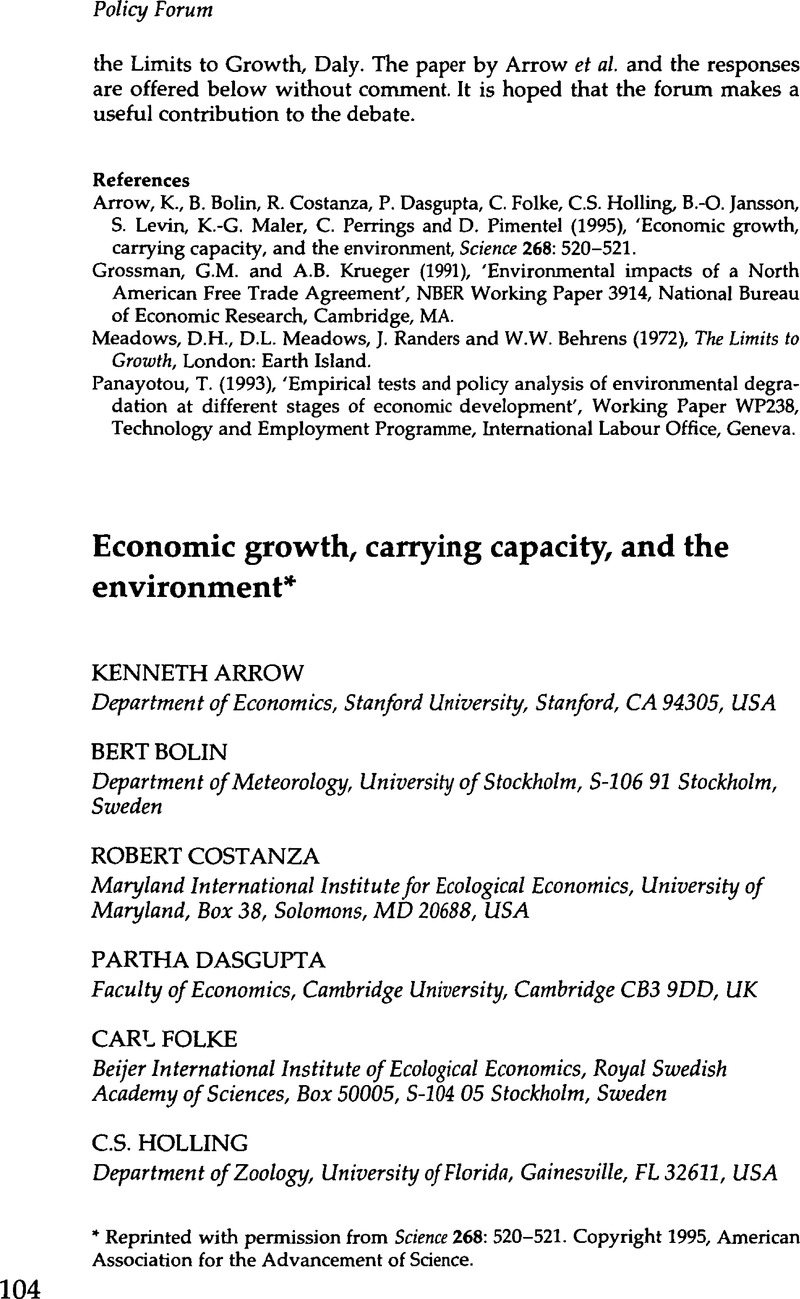Published online by Cambridge University Press: 31 July 2008

1 This is a report of the Second Askö Meeting, held 31 August to 2 September 1994, in the archipelago outside Stockholm, Sweden. The meeting was organized by the Beijer International Institute of Ecological Economics, Royal Swedish Academy of Sciences, Box 50005, S-104 05 Stockholm, Sweden. The aim of the meeting was to establish a substantive dialogue among a small group of ecologists and economists to gauge whether an interdisciplinary consensus exists on the issues of economic growth, carrying capacity, and the environment and to determine what could be said about the joint development of economic and environmental policy.
2 Phenomena for which the relation holds most clearly include poor sanitation, impure water supplies, suspended particulates, SO2, Nox, and CO (3) [Grossman, G.M. and Krueger, A.B., in The U.S. Mexico Free Trade Agreement, Garber, P., Ed. (MIT Press, Cambridge, MA, 1993), pp. 165–177Google Scholar].
3 Shafik, N. and Bandyopadhay, S., ‘Economic growth and environmental quality: time series and cross country evidence’ (background paper for the World Development Report, World Bank, Washington, DC, 1992).Google Scholar
4 Beckerman, W., World Dev. 20, 481 (1992).CrossRefGoogle Scholar
5 Jansson, A.M., Hammer, M., Folke, C., Costanza, R., eds, Investing in Natural Capital: the Ecological Economics Approach to Sustainability (Island Press, Washington, DC, 1994).Google Scholar
6 N.Shafik and S.Bandyopadhay (3) find that CO2 emissions are an increasing function of per capita income. Moomaw, W. and Tullis, M. [in Industrial Ecology and Global Change, Socolow, R., Andrews, C., Berkhout, F., Thoms, V., eds. (Cambridge Univ. Press, Cambridge, 1994), pp. 157–172] show that while cross-sectionally CO2 emissions per capita rise with income per capita, the experience in individual countries over time is highly variable, depending on the structure of individual economies. They conclude that there are many different development paths, some of which can de-link economic growth from CO2 emissions, but adequate institutions are required and it is by no means an automatic consequence of growth.CrossRefGoogle Scholar
7 Lopez, R., J. Environ. Econ. Manage. 27, 163 (1994)Google Scholar; Selden, T.M. and Song, D.; J. Environ. Econ. Manage, p. 147Google Scholar; Anderson, K. and Blackhurst, R., eds, The Greening of World Trade Issues (Harvester Wheatsheaf, Hemel Hempstead, Herts, UK, 1992).Google Scholar
8 A related issue is the measurement of economic growth at the macro level. The conventional measure, GNP, is far from adequate as a measure of true economic performance. We need a more comprehensive index that includes the flow of environmental services as well as the value of net changes in the stocks of natural capital so that the true social costs of growth can be internalized. With this improved index, many of the apparent conflicts between ‘growth’ and the environment would disappear because environmental degradation would be subtracted from the index. [See, for example, Dasgupta, P. and Mäler, K.-G., The Environment and Emerging Development Issues, Proceedings of the Annual Bank Conference on Development Economics, 1990 (Supplement to the World Bank Economic Review, 1991).]Google Scholar
9 Vitousek, P.M., Ehrlich, P.R., Ehrlich, A.H., Matson, P.A., BioScience 36, 368 (1986).CrossRefGoogle Scholar
10 Another way is to focus on ecosystem dynamics in the neighborhood of an equilibrium. The object here is to measure the resistance of a system to disturbances and to determine the speed with which it returns to equilibrium. [See Pimm, S.L., Nature 307, 321 (1984).]CrossRefGoogle Scholar
11 Holling, C.S., Annu. Rev. Ecol System. 4,123 (1973).CrossRefGoogle Scholar
12 Adaptive management views regional development policy and management as ‘experiments’, where interventions at several scales are made to achieve understanding, to produce a social or economic product, and to identify options. [See, for example, Holling, C.S., ed., Adaptive Environmental Assessment and Management (Wiley, London, 1978)Google Scholar; Walters, C.J., Adaptive Management of Renewable Resources (Macmillan, New York, 1986)Google Scholar; Lee, K., Compass and the Gyroscope (Island Press, Washington, DC, 1993).Google Scholar
13 We thank the two anonymous referees for helpful comments.